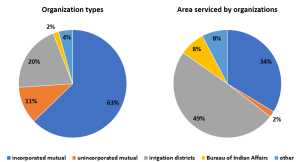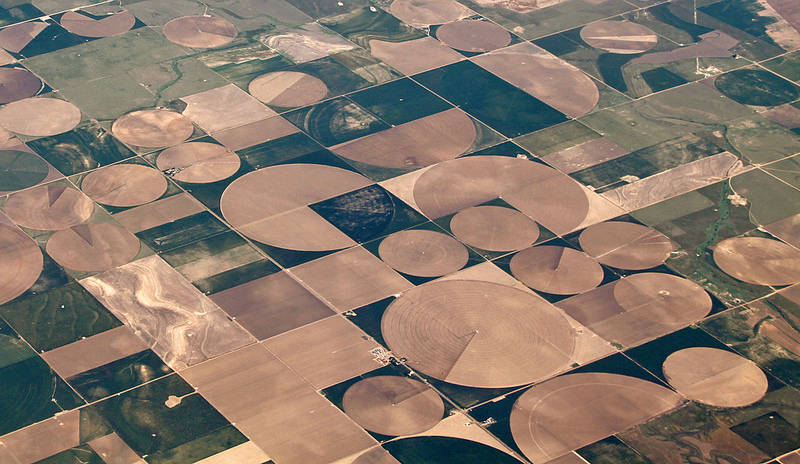Irrigated agriculture is an important component of the US farm sector, particularly in the arid western US. According to the USDA’s Economic Research Service, data from the 2012 Census of Agriculture indicate that 28 percent of harvested cropland is irrigated, but that roughly half of the total value of all crop sales comes from irrigated land. Despite the significance of irrigation water as an input to crop production, we know relatively little about the organizations and entities responsible for delivering and managing the water used on many irrigated farm operations. In an effort to fill this gap, the USDA recently conducted the 2019 Survey of Irrigation Organizations (SIO), the first effort of its kind since the last similar survey was completed in 1978. This blog post will focus on some of the highlights from the SIO pertaining to the Eastern Rockies region, which is made up of Montana, Wyoming, and Colorado.
Overall, the SIO indicates there are 898 irrigation organizations operating in the Eastern Rockies. To get a back-of-the-envelope sense of the reach of these entities, the 2018 Irrigation and Water Management Survey reports there being 6,160,500 acres of irrigated land in the three states making up the region. The SIO reports 4,415,000 acres associated with deliveries from irrigation organizations, implying that approximately 72% of the irrigated land in the Eastern Rockies depends, at least in part, on water managed by irrigation organizations.
Although the delivery of water to irrigated farms is a primary purpose of nearly all of these organizations, 19% also cite groundwater management as a primary function. (Note that organizations can report multiple primary and secondary functions.) In addition, many organizations participate in a variety of activities that fall outside the scope of irrigation water delivery. Common secondary functions include the provision of municipal/residential water (11% reporting), farm drainage management (10%), and recreation or wildlife management (7%). As a result, in addition to supplying the irrigation water necessary to sustain crop production in the Eastern Rockies, irrigation organizations can have far-reaching impacts on both rural and urban economies.
Irrigation organizations are structured in a variety of ways, but most in the Eastern Rockies come in the form of incorporated mutual companies, irrigation districts, and unincorporated mutual companies. Incorporated mutuals are the most common type of delivery organization in the region, accounting for 63% of the surveyed entities. These organizations serve an average of 30 farm operations and 2,682 acres of irrigated farmland (34% of all land serviced by organizations). While irrigation districts make up just 20% of organizations, they tend to be much larger, serving an average of 195 organizations and 12,424 acres of farmland (49% of all land serviced by organizations). Unincorporated mutual companies are fewer in number and tend to service relatively small land areas. The survey results also note the presence of 15 organizations falling under the management of the Bureau of Indian Affairs, which service very large tracts of land averaging 22,265 acres. The 175 groundwater organizations operating in the Eastern Rockies manage an average of 5,666 acres and 51 active wells. In addition, 13% of the groundwater management organizations are involved in managed aquifer recharge, an activity that has gained traction in recent years as a strategy to replenish depleted groundwater reserves.

Although changes to the scope and design of the surveys preclude an apples-to-apples comparison between the 2019 results and those from the 1978 survey, a couple of things stand out. First, there is a massive drop in the number of organizations reported over the past 41 years. In 1978, there were 2,936 organizations operating in the Eastern Rockies, compared to 898 in 2019. The irrigated land area associated with these organizations also dropped from 5.7 to 4.4 million acres. The discrepancy in the acreage and organization count changes implies that many small organizations have either dissolved or were consolidated into the larger organizations we see today. Second, the 1978 survey results make no mention of groundwater management as a primary organizational function, highlighting how institutional management of aquifers has grown in response to concerns over aquifer depletion.
Increased drought frequency and severity, coupled with ever-growing stresses placed on water systems from population growth and other non-farm sources, heighten the need to promote prudent water management now and in years to come. Montana, for instance, has experienced rapid population growth in recent decades and, as of the end of January, 86% of the state is experiencing abnormally dry or drought-like conditions. Given their far reach and multi-purpose aims, it is clear that irrigation organizations will play a key role in shaping the future of water resource management throughout the US.

